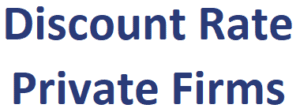Discount Rate Private Firms
Estimating the discount rate in a private firm valuation can be quite challenging for the following reasons:
- size premiums,
- Availability and cost of debt,
- Acquirer versus target,
- Projection risk,
- Lifecycle stage.
On this page discuss each of these potential challenges in more detail. These considerations will primarily impact the appropriate discount rate to use in a private firm valuation.
Size premiums
Size premiums are often added to the discount rate for small private companies. Estimating the size premium using small public firm data may be biased upward by the fact that many of the small firms in the sample are experiencing financial distress.
Availability and cost of debt
The second consideration is the availability and cost of debt. A private firm may have less access to debt financing than a public firm. Because equity capital is usually more expensive than debt and because the higher operating risk of smaller private companies result in higher cost of debt as well. The weighted average cost of capital (WACC) will typically be higher for private firms.
Acquirer versus target
When acquiring a private firm, some acquirers may incorrectly use their own (lower) cost of capital, rather than the higher rate appropriate for the target. This will lead the acquiring firm to arrive at a value for the target company that is too high. As a consequence, the acquirer may overpay.
Projection risk
Because of the lower availability of information from private firms and managers who are inexperienced at forecasting, the projections may not be very accurate. To address this, the analyst should increase the discount rate used.
Management may not be sufficiently experienced with forecasting financial results and may underestimate or overestimate future earnings, requiring adjustment by the analyst. Such adjustments are highly subjective, however.
Lifecycle stage
It is particularly difficult to estimate the discount rate for firms in their early stage of development. If such firms have unusually high levels of unsystematic risk, the use of the CAPM may be inappropriate. Although ranges of discount rates can be specified for the various lifecycle stages, it may be difficult to classify the stage a firm is in.
Summary
We discussed at least five considerations that are at play when determining what discount rate private equity firms should use for private firm valuation.

